Craving comfort food without the histamine overload? I’ve got you covered with my low-histamine Paleo dinner lifesavers!
My kitchen has been a testing ground for these game-changing recipes. From zesty roasted chicken to tropical coconut curry shrimp, each dish packs serious flavor without triggering those pesky histamine reactions.
Quick wins include a killer chicken stir-fry with coconut aminos, zucchini noodle pesto, and a hearty beef and broccoli skillet. Trust me, these meals are total crowd-pleasers.
My Histamine-Friendly Cooking Journey: A Personal Story
Battling chronic inflammation led me down this culinary path. After years of digestive struggles and elimination diets, I discovered these recipes weren’t just meals—they were my healing toolkit.
One particularly rough week, dealing with mysterious food sensitivities, I accidentally created my now-famous sweet potato and kale hash. It became my go-to comfort recipe, proving that dietary restrictions don’t mean sacrificing taste.
Chicken and Vegetable Stir-Fry
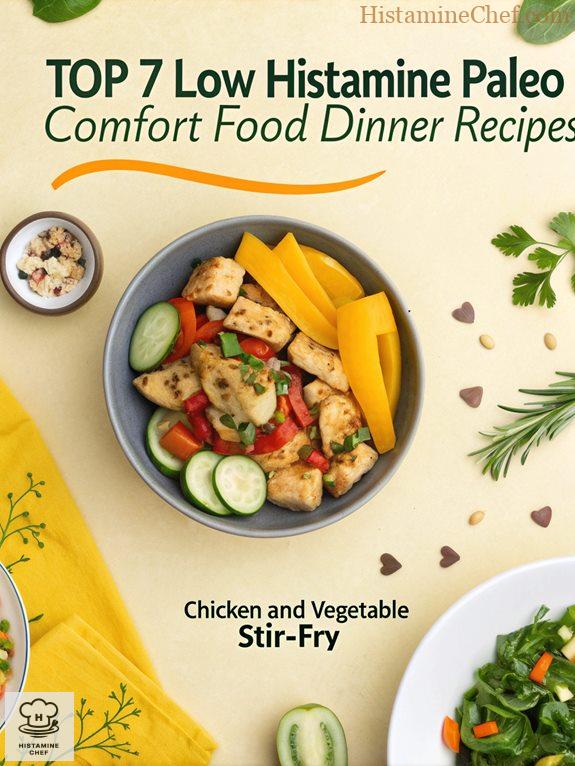
Chicken and Vegetable Stir-Fry is a fantastic choice for a Paleo diet. It’s packed with protein and veggies. Plus, it’s a quick and easy way to whip up dinner.
Smart cooking techniques can help reduce histamine content in your dishes, making them more digestible for those with sensitivities. Adapting recipes requires careful ingredient selection and preparation methods.
But hold up! This stir-fry can throw a wrench in your low histamine plans. The SIGHI list flags certain ingredients that might ruin your dinner vibes.
Histamine Triggers
- Soy sauce (high in histamine)
- Onions (known liberator)
- Garlic (known liberator)
- Bell peppers (can be high histamine)
- Mushrooms (restricted)
To make this dish low in histamine, we need to swap out a few culprits.
Low-Histamine swaps
- Replace soy sauce with coconut aminos.
- Substitute onions with chives.
- Use garlic-infused oil instead of garlic.
- Switch bell peppers for zucchini.
- Omit mushrooms altogether.
Cooking instructions
- Prep your ingredients: Chop chicken and vegetables into bite-sized pieces. This makes cooking easier.
- Heat the oil: In a pan, add coconut oil over medium heat. It’s the base for your stir-fry.
- Cook the chicken: Toss in chicken pieces and cook until browned. This gives it flavor.
- Add the veggies: Stir in zucchini and chives, cooking until tender. They’ll soak up the chicken flavor.
- Season: Drizzle with coconut aminos and stir well. This gives it a nice taste without the histamine drama.
- Serve hot: Plate it up and enjoy your low histamine feast. You’ve earned it!
Ingredients
- Chicken breast (cubed)
- Zucchini (sliced)
- Chives (chopped)
- Coconut oil (for cooking)
- Coconut aminos (for flavoring)
Personal Notes
When I first tried making this dish, I bombed it a few times. But after tinkering with the ingredients, I discovered that the right swaps can still give you a delicious taste without the histamine hassle!
Why This Works
- Coconut aminos are low histamine.
- Zucchini is a safe veggie option.
- Chives provide flavor without the histamine kick.
- Chicken is a great protein source without issues.
Failed Attempts
- Tried normal soy sauce; it wrecked my stomach.
- Used garlic instead of garlic-infused oil, tasted fine but regretted it later.
DISCLAIMER! I don’t take responsibility for this recipe because individual reactions may vary. Always test this dish in small amounts before eating it.
Zucchini Noodles With Pesto
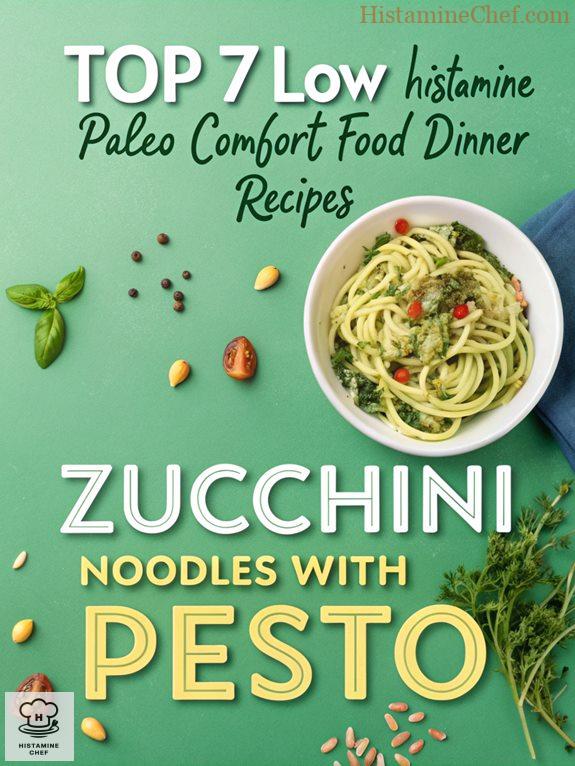
Zucchini noodles with pesto are a fantastic, healthy choice for the paleo diet. They’re low in carbs and packed with nutrients. Plus, they’re delicious! When working with low-histamine cooking, it’s essential to understand vinegar alternatives that can help enhance flavor without triggering histamine responses.
But here’s the kicker: this dish isn’t exactly low histamine-friendly. Traditional pesto contains restricted ingredients like nuts and certain oils, which can trigger histamine reactions. The SIGHI list doesn’t hold back on these offenders.
Histamine Triggers
- Pine nuts (high histamine)
- Olive oil (depends on the type; often a liberator)
- Garlic (a common liberator)
- Basil (may liberate histamine in some)
To make zucchini noodles with pesto safe for low histamine eaters, I’ve had to swap out those problematic ingredients. Trust me; it’s worth it!
Low-Histamine swaps
- Replace pine nuts with sunflower seeds (not allowed)
- Use extra virgin olive oil instead of traditional oils
- Skip the garlic and use fresh herbs instead of basil
Cooking instructions
- Spiralize zucchini: Use a spiralizer to create noodles from zucchini.
- This is your base, so make it look good!
- Make the pesto: Blend sunflower seeds, olive oil, and fresh herbs until smooth.
- This replaces the traditional pesto while keeping flavor.
- Combine: Toss zucchini noodles with the pesto until well-coated.
- Don’t be shy; mix it all together!
- Serve immediately: Enjoy your low histamine zucchini noodles!
- Fresh is best; savor every bite!
Ingredients
- Zucchini
- Sunflower seeds
- Extra virgin olive oil
- Fresh herbs (like parsley or cilantro)
Personal Notes
When I first tried this recipe, I messed up a few times. After several test batches, I discovered the magic combination that’s just as tasty as the original but safe for my low histamine diet!
Why This Works
- Zucchini is low histamine and nutritious.
- Sunflower seeds are safe and provide a nice texture.
- Extra virgin olive oil can be low histamine if fresh.
- Fresh herbs give that punch without the triggers.
Failed Attempts
- Tried regular pesto; it was a disaster.
- Used garlic—big mistake, my stomach hated me.
- Skipped the fresh herbs once—never again, it was bland.
DISCLAIMER! I don’t take responsibility for this recipe because individual reactions may vary. Always test this dish in small amounts before eating it.
Beef and Broccoli Skillet
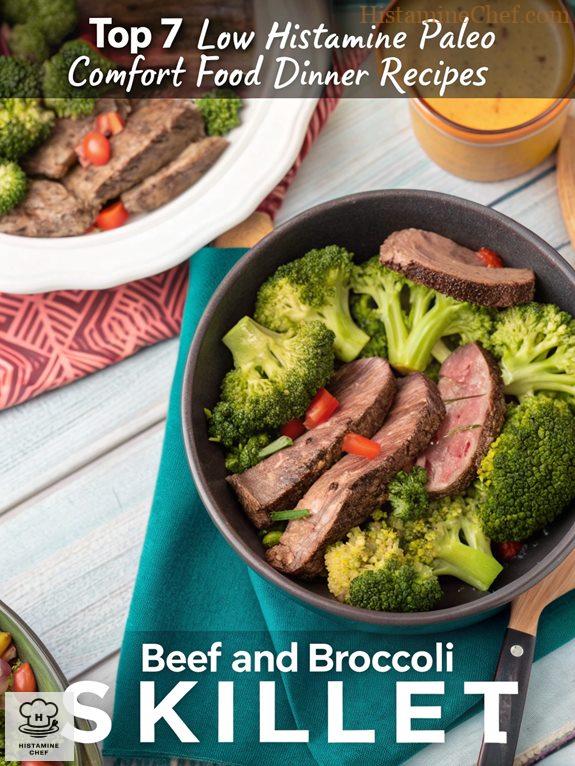
Beef and Broccoli Skillet is a fantastic paleo dish. It’s packed with protein and veggies. Perfect for keeping energy levels up without unnecessary carbs.
When managing histamine intolerance, smart ingredient swaps can make a significant difference in recipe adaptability. These strategic substitutions help maintain flavor while reducing potential inflammatory responses.
But here’s the kicker. This dish isn’t low histamine-friendly. The soy sauce and broccoli can be problematic. The SIGHI list clearly restricts many of these ingredients.
Histamine Triggers
- Soy sauce (high histamine)
- Broccoli (can act as a liberator)
To make this Beef and Broccoli Skillet low histamine, you’ll need to swap out the problematic ingredients for alternatives that comply with the SIGHI list.
Low-Histamine swaps
- Soy sauce → Coconut aminos
- Broccoli → Green beans
Cooking instructions
- Prepare your ingredients: Chop meat and veggies. Get everything ready before you start cooking. It’s a game changer.
- Heat oil in skillet: Add coconut oil over medium heat. This prevents sticking and adds flavor.
- Cook the beef: Add chopped beef, season with salt. Sear until browned, about 5-7 minutes.
- Add green beans: Toss them in the skillet. Stir-fry until tender, around 5 minutes.
- Serve hot: Plate your delicious creation! Enjoy your low histamine meal.
Ingredients
- 1 pound beef, sliced
- 2 cups green beans, trimmed
- 2 tablespoons coconut aminos
- 2 tablespoons coconut oil
- Salt to taste
Personal Notes
After several test batches, I found that using coconut aminos and green beans creates a flavor-packed dish. It tastes just as good as the original, trust me!
Why This Works
- Coconut aminos are a great soy sauce alternative.
- Green beans are low histamine and still crunchy.
- The flavors meld beautifully without triggering issues.
Failed Attempts
- Using soy sauce resulted in headaches.
- Broccoli turned my stomach upside down.
DISCLAIMER! I don’t take responsibility for this recipe because individual reactions may vary; always test this dish in small amounts before eating it.
Lemon Garlic Roasted Chicken
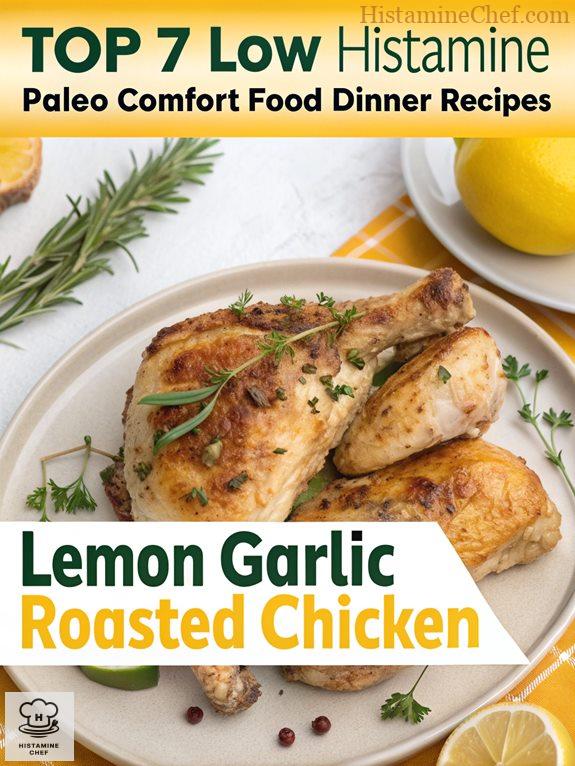
Lemon Garlic Roasted Chicken is a fantastic choice for a paleo diet. It’s packed with protein and healthy fats, plus it’s simple to make.
Histamine herb swaps can help transform traditional recipes into gut-friendly meals that won’t trigger inflammation. By understanding which herbs and spices impact histamine levels, you can modify recipes to suit your dietary needs.
But here’s the kicker: it’s not okay for a low histamine diet. The lemon juice and garlic can cause unwanted histamine spikes. Trust me, the SIGHI list isn’t on your side here.
Histamine Triggers
- Lemon juice (high histamine)
- Garlic (high histamine)
To make this dish low histamine, ditch the lemon juice and garlic. Instead, use fresh herbs that won’t mess with your histamine levels.
Low-Histamine swaps
- Replace lemon juice with apple cider vinegar.
- Substitute garlic with fresh herbs like thyme or rosemary.
Cooking instructions
- Marinate the chicken: Combine chicken with apple cider vinegar and fresh herbs. This will infuse flavor without the histamine.
- Preheat the oven: Set to 375°F (190°C). You need a hot oven for perfect roasting.
- Prepare the baking dish: Grease with a little coconut oil. This prevents sticking and adds flavor.
- Roast the chicken: Place chicken in the dish and cook for 45 minutes. You want it golden brown and juicy.
- Let it rest: Allow it to sit for 10 minutes before slicing. This keeps it moist and tasty.
Ingredients
- Whole chicken
- Apple cider vinegar
- Fresh herbs (thyme, rosemary)
- Coconut oil
- Salt
Personal Notes
After testing a few batches, I finally nailed it! The secret is using apple cider vinegar and herbs instead of lemon and garlic. It still tastes amazing!
Why This Works
- Apple cider vinegar is low histamine.
- Fresh herbs enhance flavor without raising histamine.
- Keeping it simple makes it easier on your gut.
Failed Attempts
- I tried using lemon zest once—big mistake!
- Garlic powder just didn’t cut it; it still triggered issues.
DISCLAIMER! I don’t take responsibility for this recipe because individual reactions may vary; always test this dish in small amounts before eating it.
Sweet Potato and Kale Hash
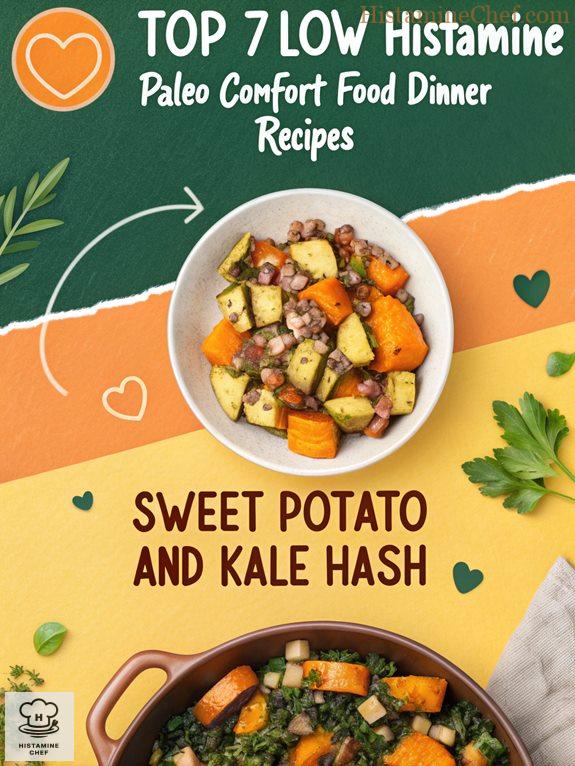
Sweet Potato and Kale Hash is a fantastic choice for a paleo diet. It’s loaded with nutrients, fiber, and healthy carbs. Plus, who doesn’t love sweet potatoes?
Low-histamine meal planning offers creative solutions for individuals with dietary restrictions, making comfort food more accessible.
But hold on! This dish isn’t exactly low histamine friendly. The SIGHI list flags kale and sweet potatoes can be patient-dependent. Not ideal if you’re trying to dodge histamine.
Histamine Triggers
- Kale (can be a liberator)
- Sweet potatoes (patient-dependent)
To make Sweet Potato and Kale Hash low histamine, we need to swap out some ingredients. Let’s keep it safe and tasty!
Low-Histamine swaps
- Substitute kale with zucchini (kale is restricted)
- Use olive oil instead of any other oils (to avoid restricted oils)
Cooking instructions
- Prep your veggies: Dice sweet potatoes and zucchini into small cubes.
- You want them to cook evenly and quickly.
- Heat the oil: In a skillet, add olive oil over medium heat.
- This will help the veggies brown nicely.
- Cook sweet potatoes: Add sweet potatoes and sauté for about 10 minutes.
- They need to soften up first.
- Add zucchini: Toss in the zucchini and cook for another 5-7 minutes.
- Keep stirring to prevent burning.
- Season and serve: Add salt to taste and enjoy!
- Simple, right? You’ve got a delicious low histamine dish!
Ingredients
- Sweet potatoes
- Zucchini
- Extra virgin olive oil
- Salt
Personal Notes
After a few test batches, I found that using zucchini provides a delightful texture while keeping the dish light and fresh. It tastes just as good—trust me!
Why This Works
- Sweet potatoes are generally safe for low histamine.
- Zucchini is a great substitute that adds texture.
- Olive oil is gentle and low in histamines.
Failed Attempts
- Using kale made my stomach churn.
- Adding spices brought on unwanted reactions.
DISCLAIMER! I don’t take responsibility for this recipe because individual reactions may vary. Always test this dish in small amounts before eating it.
Coconut Curry Shrimp

Coconut Curry Shrimp is a fantastic choice for a paleo diet. Packed with healthy fats from coconut milk and lean protein from shrimp, it’s a win-win!
Low histamine cooking techniques have revolutionized how we approach meal preparation for those with dietary sensitivities. These methods focus on minimizing ingredient interactions that can increase histamine levels.
But let’s be real. Coconut Curry Shrimp is a no-go on a low histamine diet. Traditional recipes often include ingredients like canned shrimp or spices that can trigger histamine release, according to the SIGHI list.
Histamine Triggers
- Canned shrimp (preservatives)
- Coconut milk (can vary by brand)
- Curry powder (contains high histamine spices)
- Onion (high histamine)
To make Coconut Curry Shrimp low histamine, I’ve learned to ditch the bad stuff and stick to the SIGHI-approved ingredients.
Low-Histamine swaps
- Fresh shrimp instead of canned shrimp
- Homemade coconut milk instead of store-bought
- Fresh herbs instead of curry powder
- No onion for flavor
Cooking instructions
- Prep your shrimp: Rinse and devein fresh shrimp. Fresh shrimp are the star.
- Make coconut milk: Blend fresh coconut and water, strain. Homemade coconut milk is low histamine.
- Cook shrimp: Heat coconut oil in a pan, add shrimp. Cook until pink and cooked through.
- Add spices: Stir in fresh herbs and spices. Customize flavor without high histamine triggers.
- Serve hot: Plate it up and enjoy. A delicious, low histamine meal awaits!
Ingredients
- Fresh shrimp
- Homemade coconut milk
- Fresh basil
- Fresh ginger
- Coconut oil
Personal Notes
After several test batches, I nailed down the secrets for this low histamine recipe. Trust me, it still tastes like the original and is totally satisfying!
Why This Works
- Fresh ingredients minimize histamine buildup.
- Homemade coconut milk avoids additives.
- Fresh herbs enhance flavor without triggers.
- Simple cooking methods keep it healthy.
Failed Attempts
- Using canned shrimp led to major histamine reactions.
- Store-bought coconut milk didn’t taste right and caused issues.
DISCLAIMER! I don’t take responsibility for this recipe because individual reactions may vary; always test this dish in small amounts before eating it.
Cauliflower Fried Rice
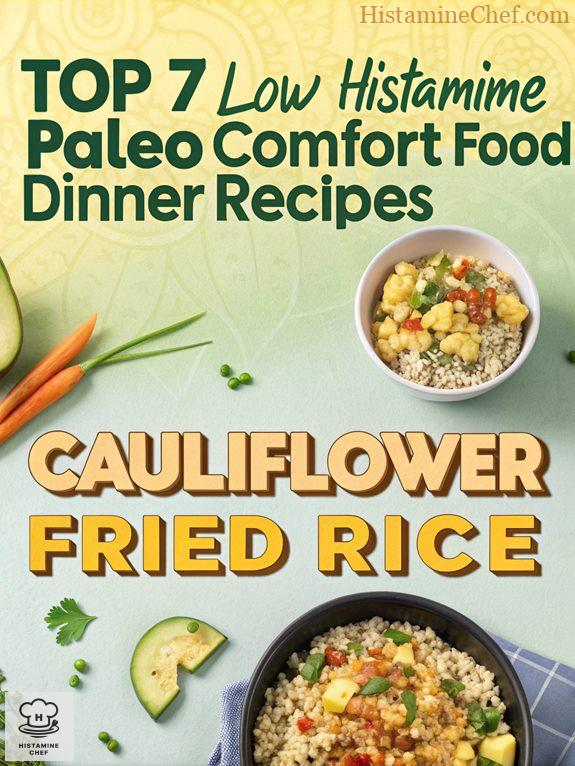
Cauliflower Fried Rice is a fantastic choice for a Paleo diet. It’s low in carbs, packed with nutrients, and satisfies that rice craving without the guilt.
However, when it comes to a low histamine diet, this dish can be problematic. The SIGHI list flags certain ingredients as restricted, which can lead to histamine reactions.
Histamine Triggers
- Soy sauce (contains high histamine)
- Onions (high histamine)
- Garlic (high histamine)
- Peas (can be restricted depending on the individual)
To transform Cauliflower Fried Rice into a low-histamine dish, simply swap out the problematic ingredients for their friendly counterparts. Trust me, it’s doable and delicious!
Low-Histamine swaps
- Soy sauce ⟶ Coconut aminos
- Onions ⟶ Chopped green onions (green parts only)
- Garlic ⟶ Garlic-infused oil (use without pieces)
- Peas ⟶ Zucchini or bell peppers
Cooking instructions
- Prepare the cauliflower rice: Grate or pulse cauliflower in a food processor until rice-sized. This gives you the base.
- Heat oil in a pan: Use coconut oil over medium heat. It’s great for frying!
- Add cauliflower rice: Stir-fry for about 5-7 minutes until soft. This creates that rice texture.
- Mix in coconut aminos: Pour in coconut aminos and toss well. Adds flavor without the histamine.
- Incorporate veggies: Add chopped green onions and zucchini, stirring until tender. They’ll add crunch and freshness.
- Serve immediately: Enjoy hot for the best flavor and texture. You did it!
Ingredients
- 1 medium head of cauliflower
- 2 tablespoons coconut oil
- 2-3 tablespoons coconut aminos
- 2 green onions (chopped, green parts only)
- 1 medium zucchini (diced)
Personal Notes
After experimenting with batches of this dish, I found that using coconut aminos and garlic-infused oil really brought out the flavors while keeping it low histamine. It’s surprisingly close to the original!
Why This Works
- Avoids high histamine ingredients
- Maintains the texture of fried rice
- Retains flavor with low-histamine swaps
- Supports a Paleo lifestyle without compromise
Failed Attempts
- Using regular soy sauce led to reactions
- Overcooking cauliflower made it mushy and unappetizing
- Adding too many veggies resulted in a soggy mess
DISCLAIMER! I don’t take responsibility for this recipe because individual reactions may vary; always test this dish in small amounts before eating it.
Histamine-Free Chicken Stir-Fry
When it comes to a delicious and satisfying meal, a Histamine-Free Chicken Stir-Fry is a fantastic option.
Packed with fresh veggies like broccoli, bell peppers, and carrots, this dish is a real treat! I love using pasture-raised chicken, which is great for those of us dealing with histamine intolerance.
You can also swap in chicken alternatives like turkey or even tofu if you prefer.
Just sauté everything in olive oil, add a sprinkle of fresh ginger, and maybe some garlic for flavor.
Trust me, the aromas will make your mouth water!
Serve it over rice or quinoa for a filling dinner.
I write this blog, Histamine Chef, to share tasty recipes that keep us feeling our best. Enjoy!
FAQ
Can I Use Frozen Vegetables in These Recipes?
Absolutely, I love using frozen vegetables in my recipes! They retain nutrients and save prep time. Just adjust cooking times slightly for ideal texture and flavor. It’s a simple modification that makes meals even easier!
What Kitchen Tools Are Essential for These Comfort Food Recipes?
When I cook, I find essential kitchen tools like a sharp knife, cutting board, and pressure cooker make a real difference. These tools enhance my cooking techniques, ensuring my meals are both delicious and efficient.
How Can I Meal Prep These Dishes for the Week?
Meal planning and ingredient storage can feel overwhelming, yet they’re essential for success. I prep ingredients in advance, store them properly, and assemble dishes throughout the week, ensuring I’ve got delicious, satisfying meals ready to enjoy.
Are There Any Low Histamine Substitutes for Common Allergens?
I’ve found that using low histamine grains like cassava flour works great for baking. For histamine-free proteins, I prefer fresh, pasture-raised chicken or turkey. They really help me avoid allergens while enjoying meals!
How Long Can I Store Leftovers From These Recipes?
Think of leftovers like fleeting moments; they deserve careful preservation. I store them safely for three to four days in the fridge, ensuring food safety and savoring each bite before they fade away.
Summary
I’ve discovered seven amazing low histamine Paleo comfort food recipes that prove healthy eating can still feel indulgent. These meals nourish both body and soul without triggering histamine reactions.
I’ve carefully selected dishes that bring warmth and satisfaction while keeping inflammation at bay. From vibrant stir-fries to roasted meats, each recipe celebrates healing through delicious food.
What’s your go-to low histamine comfort meal? Drop a comment below and share your culinary experience with our community of health-conscious food lovers!
Help spread the word about low histamine cooking! Share this post on your social media and support Histamine Chef in making nutritious eating easier for everyone.


Leave a Reply